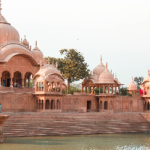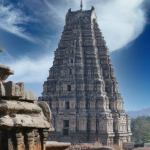Gangtok, the capital city of Sikkim, India, stands as a vibrant and popular tourist destination known for its breathtaking landscapes, rich cultural heritage, and tranquil ambiance. Nestled in the lap of the Himalayas, Gangtok allures visitors with its stunning vistas, diverse attractions, and a blend of tradition and modernity.
The best time to visit Gangtok largely depends on your interests and preferences, considering the distinct characteristics of each season. The city experiences different seasons, each offering unique experiences:
- Spring (March to May): This season in Gangtok witnesses a burst of colors as flowers bloom across the region. The weather is pleasant, making it an ideal time for nature lovers and those interested in exploring the vibrant flora, including the famed rhododendrons.
- Summer (June to August): The summer season brings mild temperatures, but it’s also when Gangtok experiences its monsoon. While the lush greenery flourishes, intermittent rainfall may limit outdoor activities. However, this time is perfect for those seeking a quieter, less crowded experience.
- Autumn (September to November): Considered one of the best times to visit Gangtok, autumn offers clear skies, comfortable temperatures, and spectacular views of the surrounding mountain ranges. This season is excellent for trekkers, sightseers, and adventure enthusiasts.
- Winter (December to February): Winter in Gangtok brings cold temperatures and occasional snowfall. For snow enthusiasts and those wanting to witness a snowy landscape, this season is perfect. It’s an ideal time for experiencing winter sports, although some areas might be inaccessible due to heavy snowfall.

Regardless of the season, Gangtok’s allure remains consistent throughout the year, offering a range of experiences for visitors. Whether it’s exploring monasteries, indulging in adventure activities, savoring local cuisine, or simply taking in the panoramic views of the Himalayas, Gangtok has something to offer for every traveler’s preference and inclination.
Spring (March to May)
Absolutely. Spring, spanning from March to May, presents a delightful ambiance in Gangtok, offering visitors a blend of favorable weather conditions and a burst of natural beauty. Here are some characteristics of the spring season in Gangtok:
- Pleasant Weather and Blooming Flora: Gangtok experiences mild and enjoyable temperatures during spring. The skies are generally clear, providing splendid views of the surrounding landscapes. The region comes alive with an array of vibrant flowers in full bloom, most notably the rhododendrons that paint the hillsides with their vivid colors.
- Ideal for Sightseeing and Outdoor Activities: The pleasant weather conditions make it an ideal time for sightseeing. Visitors can explore the city’s cultural and natural attractions, including monasteries, viewpoints, and parks. Additionally, spring is perfect for outdoor activities like trekking, camping, and mountain biking, as the weather is conducive to such adventures.
- Peak Tourist Season: Spring is one of the peak tourist seasons in Gangtok due to the favorable weather and the stunning natural display of blooming flowers. Consequently, the city tends to see higher tourist footfall, leading to crowded attractions and accommodations. It’s advisable to plan and book in advance and be prepared for higher prices during this time.
For travelers who appreciate pleasant weather, vibrant landscapes, and engaging in outdoor activities, spring in Gangtok provides an excellent opportunity to immerse themselves in the city’s natural beauty and explore its cultural treasures.
Summer (June to August)
During the summer months, from June to August, Gangtok experiences a distinctive climate and ambiance, presenting both advantages and considerations for visitors:
- Warm Weather with Rain Showers: Summer in Gangtok brings relatively warmer temperatures. However, it is also the monsoon season, characterized by intermittent rain showers. The lush greenery flourishes during this time, contributing to the city’s scenic beauty.
- Possibility of Landslides: Heavy rainfall can lead to landslides, especially in hilly areas, affecting transportation and causing potential travel disruptions. Visitors are advised to stay updated on weather conditions and exercise caution while traveling.
- Ideal for Budget Travelers: Summer is typically a less crowded period in Gangtok due to the monsoon and the possibility of landslides. As a result, there are fewer tourists, leading to lower accommodation prices and lesser crowded attractions. It can be an excellent time for travelers looking to explore the city while staying within a budget.
For those undeterred by occasional rain and seeking a quieter, less crowded experience, visiting Gangtok during the summer months can offer the opportunity to appreciate the lush green landscapes and take advantage of more affordable prices, despite the potential weather-related challenges. However, it’s crucial to stay cautious and flexible due to the unpredictability of the weather during this season.
Autumn (September to November)
In Gangtok, the autumn months from September to November bring about a delightful and moderate climate, offering a range of experiences for visitors:
- Pleasant Weather with Vibrant Foliage: Autumn in Gangtok features mild temperatures and clear, sunny skies. The surroundings take on a picturesque charm as the leaves on trees begin to change colors, creating a vibrant display of reds, yellows, and oranges across the landscape.
- Ideal for Sightseeing and Outdoor Activities: The pleasant weather during autumn makes it an excellent time for sightseeing. Visitors can explore the city’s attractions, including monasteries, viewpoints, and cultural sites. It’s also an ideal time for outdoor activities such as trekking, hiking, and other adventures due to the comfortable weather conditions.
- Moderate Tourist Crowds: Although autumn is a popular time to visit Gangtok, the number of tourists is generally lower than during the peak spring season. Despite the reduced crowds, some popular attractions might still see a moderate influx of visitors.
For travelers seeking comfortable weather, stunning foliage, and a balance between sightseeing and outdoor activities, autumn in Gangtok offers a favorable environment. The season provides an opportunity to explore the city and its surroundings with relatively fewer crowds compared to the peak tourist months, allowing for a more relaxed and immersive experience.
Winter (December to February)
Winter in Gangtok, spanning from December to February, offers a distinct experience marked by cold temperatures and occasional snowfall, presenting both opportunities and considerations for visitors:
- Cold Weather and Occasional Snowfall: The winter months bring chilly temperatures to Gangtok. At higher altitudes, occasional snowfall might occur, transforming the landscape into a picturesque winter wonderland.
- Possible Closures and Travel Disruptions: Due to snowfall, some roads leading to high-altitude attractions or viewpoints may be closed or inaccessible. It’s essential for travelers to stay informed about road conditions and potential travel disruptions caused by snow.
- Ideal for Winter Sports: Winter is an excellent time for enthusiasts interested in winter sports like skiing and snowboarding. Certain areas, such as the nearby Tsomgo Lake, offer opportunities for these activities, attracting visitors seeking snowy adventures.
- Fewer Tourists and Lower Prices: Winter in Gangtok typically sees fewer tourists due to the cold weather and potential travel difficulties caused by snow. This reduction in tourist numbers leads to more affordable accommodation and fewer crowds at popular attractions.
For those interested in embracing the winter chill, witnessing snowfall, and engaging in winter sports, visiting Gangtok during the winter months can be an exhilarating experience. The quieter atmosphere and lower prices make it an ideal time for travelers looking to enjoy the city’s unique winter offerings. However, it’s important to be prepared for cold weather and potential travel disruptions caused by snow.
Conclusion
Gangtok, the picturesque capital of Sikkim, India, offers distinct experiences throughout the year, characterized by the varying seasons. Each season in Gangtok has its own unique charm and considerations for visitors:
- Spring (March to May): Known for pleasant weather, blooming flowers, and ideal conditions for outdoor activities, especially trekking and sightseeing. However, it’s the peak tourist season, leading to crowds and higher prices.
- Summer (June to August): Warmer temperatures, occasional rain showers, and the possibility of landslides. It’s an excellent time for budget-conscious travelers due to fewer tourists and lower prices.
- Autumn (September to November): Presents comfortable weather, colorful foliage, and moderate crowds. Ideal for sightseeing, outdoor activities, and a more relaxed experience compared to the peak season.
- Winter (December to February): Cold weather, occasional snowfall, and opportunities for winter sports like skiing and snowboarding. Fewer tourists and lower prices, but some attractions may be closed due to snow.
Gangtok, with its diverse seasons, can be enjoyed year-round, offering something for everyone. The best time to visit varies based on individual preferences and interests. Whether you prefer vibrant blooms in spring, a quieter experience in the monsoon, the scenic beauty of autumn, or the snowy adventures of winter, Gangtok caters to diverse tastes and experiences. Visitors should choose their travel time based on their desired activities and weather preferences for an unforgettable experience in this beautiful Himalayan destination.




